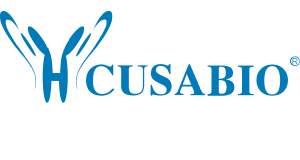Recombinant Human Formin-2 (FMN2), partial
Recombinant Human Formin-2 (FMN2), partial
SKU
CSB-EP873702HU1-1
Packaging Unit
1 mg
Manufacturer
Cusabio
Availability:
loading...
Price is loading...
Research Areas: Cell Biology
Uniprot: Q9NZ56
Buffer: If the delivery form is liquid, the default storage buffer is Tris/PBS-based buffer, 5%-50% glycerol.If the delivery form is lyophilized powder, the buffer before lyophilization is Tris/PBS-based buffer, 6% Trehalose, pH 8.0.
Form: Liquid or Lyophilized powder
Tag Info: C-terminal 6xHis-tagged
Purity: Greater than 90% as determined by SDS-PAGE.
Notes: Repeated freezing and thawing is not recommended. Store working aliquots at 4℃ for up to one week.
Molecular Weight: 57.7 kDa
Gene Names: FMN2
Organism: Homo sapiens (Human)
Source: E.coli
Expression Region: 1284-1722aa
Protein Length: Partial
Target Protein Sequence: KQPIEPCRPMKPLYWTRIQLHSKRDSSTSLIWEKIEEPSIDCHEFEELFSKTAVKERKKPISDTISKTKAKQVVKLLSNKRSQAVGILMSSLHLDMKDIQHAVVNLDNSVVDLETLQALYENRAQSDELEKIEKHGRSSKDKENAKSLDKPEQFLYELSLIPNFSERVFCILFQSTFSESICSIRRKLELLQKLCETLKNGPGVMQVLGLVLAFGNYMNGGNKTRGQADGFGLDILPKLKDVKSSDNSRSLLSYIVSYYLRNFDEDAGKEQCLFPLPEPQDLFQASQMKFEDFQKDLRKLKKDLKACEVEAGKVYQVSSKEHMQPFKENMEQFIIQAKIDQEAEENSLTETHKCFLETTAYFFMKPKLGEKEVSPNAFFSIWHEFSSDFKDFWKKENKLLLQERVKEAEEVCRQKKGKSLYKIKPRHDSGIKAKISMKT
Endotoxin: Not test.
Relevance: Actin-binding protein that is involved in actin cytoskeleton assembly and reorganization. Acts as an actin nucleation factor and promotes assembly of actin filaments together with SPIRE1 and SPIRE2. Involved in intracellular vesicle transport along actin fibers, providing a novel link between actin cytoskeleton dynamics and intracellular transport. Required for asymmetric spindle positioning, asymmetric oocyte division and polar body extrusion during female germ cell meiosis. Plays a role in responses to DNA damage, cellular stress and hypoxia by protecting CDKN1A against degradation, and thereby plays a role in stress-induced cell cycle arrest. Also acts in the nucleus: together with SPIRE1 and SPIRE2, promotes assembly of nuclear actin filaments in response to DNA damage in order to facilitate movement of chromatin and repair factors after DNA damage. Protects cells against apoptosis by protecting CDKN1A against degradation.
Uniprot: Q9NZ56
Buffer: If the delivery form is liquid, the default storage buffer is Tris/PBS-based buffer, 5%-50% glycerol.If the delivery form is lyophilized powder, the buffer before lyophilization is Tris/PBS-based buffer, 6% Trehalose, pH 8.0.
Form: Liquid or Lyophilized powder
Tag Info: C-terminal 6xHis-tagged
Purity: Greater than 90% as determined by SDS-PAGE.
Notes: Repeated freezing and thawing is not recommended. Store working aliquots at 4℃ for up to one week.
Molecular Weight: 57.7 kDa
Gene Names: FMN2
Organism: Homo sapiens (Human)
Source: E.coli
Expression Region: 1284-1722aa
Protein Length: Partial
Target Protein Sequence: KQPIEPCRPMKPLYWTRIQLHSKRDSSTSLIWEKIEEPSIDCHEFEELFSKTAVKERKKPISDTISKTKAKQVVKLLSNKRSQAVGILMSSLHLDMKDIQHAVVNLDNSVVDLETLQALYENRAQSDELEKIEKHGRSSKDKENAKSLDKPEQFLYELSLIPNFSERVFCILFQSTFSESICSIRRKLELLQKLCETLKNGPGVMQVLGLVLAFGNYMNGGNKTRGQADGFGLDILPKLKDVKSSDNSRSLLSYIVSYYLRNFDEDAGKEQCLFPLPEPQDLFQASQMKFEDFQKDLRKLKKDLKACEVEAGKVYQVSSKEHMQPFKENMEQFIIQAKIDQEAEENSLTETHKCFLETTAYFFMKPKLGEKEVSPNAFFSIWHEFSSDFKDFWKKENKLLLQERVKEAEEVCRQKKGKSLYKIKPRHDSGIKAKISMKT
Endotoxin: Not test.
Relevance: Actin-binding protein that is involved in actin cytoskeleton assembly and reorganization. Acts as an actin nucleation factor and promotes assembly of actin filaments together with SPIRE1 and SPIRE2. Involved in intracellular vesicle transport along actin fibers, providing a novel link between actin cytoskeleton dynamics and intracellular transport. Required for asymmetric spindle positioning, asymmetric oocyte division and polar body extrusion during female germ cell meiosis. Plays a role in responses to DNA damage, cellular stress and hypoxia by protecting CDKN1A against degradation, and thereby plays a role in stress-induced cell cycle arrest. Also acts in the nucleus: together with SPIRE1 and SPIRE2, promotes assembly of nuclear actin filaments in response to DNA damage in order to facilitate movement of chromatin and repair factors after DNA damage. Protects cells against apoptosis by protecting CDKN1A against degradation.

 Deutsch
Deutsch










